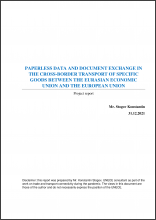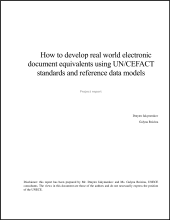
Practical assessment of the Data Pipeline concept for improving the Grain Corridor efficiency using UN/CEFACT standards
The war in Ukraine, caused by the aggression of the Russian Federation, led to a humanitarian catastrophe not only in Ukraine, but also provoked a global food crisis. The blockade of Ukrainian seaports and the impossibility of supplying Ukrainian grain and other agricultural products to the world market led to the risk of famine in many countries and a significant increase in world food prices. The limited capacity of existing transport corridors and the impossibility to increase it rapidly by traditional methods in a limited time frame has led to the need to find ways and approaches to improve the efficiency of the existing logistics infrastructure by simplifying procedures and digitalization.
The UN Economic Commission for Europe (UNECE) initiated a project to explore the practical application of the data exchange pipeline concept to improve the efficiency of this grain export corridor using UN standards.
Data mapping between selected business documents used in multimodal data and document exchange and regulatory information systems, such as Single Window and Customs systems
During this consultancy project, the Consultant analyzed the data requirements in a sample transport document aligned to the UN/CEFACT Multimodal Transport Reference Data Model (MMT RDM), the European Union Customs Data Model (EUCDM) and the WCO Data Model. The objective was to produce data mapping between these instruments, with a view to propose practical solution for using in regulatory information systems (such as regulatory Single Window, Customs systems) the information in the package of standards for the digitalization of multimodal transport data and document exchange.
UNTTC Training course on UN/CEFACT Standards
The UNTTC Training course on UN/CEFACT Standards was developed as part of the United Nations response to the challenges of the COVID-19 pandemic under the United Nations multiagency project “Transport and Trade Connectivity in the Age of Pandemics: UN solutions for contactless, seamless and collaborative transport and trade”.
Digitalization of data and document exchange for multimodal transport and trade in Azerbaijan, using the UN/CEFACT standards and reference data models
The objective of the current project is further development of the digital transport documents that could provide seamless information flows accompanying cargo flows between countries along the GUAM transport corridor. Due to its position in the middle of the cargo transport routes between Europe and Asia, the use of UN/CEFACT standards and recommendations for cargo information sharing along this route makes much sense.
Reconciling a Standardized Dataset with international standards and data models, development of schemas for electronic equivalents of railway carriage documents SMGS, CIM/SMGS and CIM in XML and JSON formats
The current project has been initiated with the main objectives to support the development of digital multimodal transport corridors, increase the harmonization and standardization of data exchange in international transport and logistics, encourage electronic data exchange and thus to reduce people-to-people contacts during the COVID-19 crisis and in the post-pandemic recovery by using the relevant standards and Multimodal Reference Data Model (MMT RDM) of the United Nations Centre for Trade Facilitation and Electronic Business (UN/CEFACT).
Analysis of information in the EDIFACT format data interchange and data matching in rail transport and the UN/CEFACT Reference Data Model for Multimodal Transport (MMT RDM)
Objective of this paper: Analyze and match data between several key documents accompanying cargo in multimodal transportation, in particular, rail transport, and the UN CEFACT Multimodal Transport Reference Data Model (MMT-RDM).
At this project phase the data shall be matched with the MMT-RDM and the first steps to create the concept of data conversion between information on rail transport between Eurasia and Western Europe and with other modes of transportation.
Data mapping of the IFTMIN UN/EDIFACT message and the SMGS and CIM/SMGS railway consignment notes to the UN/CEFACT Multimodal Transport Reference Data Model (MMT RDM)
The Data mapping of the IFTMIN UNEDIFACT message and the SMGS and CIMSMGS railway consignment notes to the UNCEFACT MMT RDM was developed as part of the United Nations response to the challenges of the COVID-19 pandemic under the United Nations multiagency project “Transport and Trade Connectivity in the Age of Pandemics: UN solutions for contactless, seamless and collaborative transport and trade”.
This electronic document equivalent Standard Package consists of the following elements:
How to develop real world electronic document equivalents using UN/CEFACT standards and reference data models
The digitalization of the supply chain is the dominant trend in international trade and transport at present and the main tool for facilitating trade procedures. Due to the essence of the supply chain as a process of interaction between many parties within many jurisdictions, ensuring interoperability plays a key role both in the supply chain and in the digitalization processes. In this regard, the development, maintenance and adoption of standards at the international level play an extremely important role. This explains the continued focus on standardization in trade and transport facilitation by UN institutions: notably, the United Nations Economic Commission for Europe (UNECE) and the United Nations Centre for Trade Facilitation and Electronic Business (UN/CEFACT).

Paperless Data and Document Exchange in the Cross-Border Transport of Specific Goods between the Eurasian Economic Union and the European Union
In the context of the recovery from the COVID-19 pandemic and the general direction of building back better this project aims to develop and practically test paperless data and document exchange in the cross-border transport of specific goods between the Eurasian Economic Union and the European Union.
Focusing on a specific pilot case of multimodal delivery of goods author of this study conducted research and offered practical recommendations how to align used by different participants in the supply chain in their IT systems to the UN/CEFACT standards and Multimodal Transport Reference Data Model, allowing for a seamless exchange of electronic data and documents (B2B exchange), as well as developing electronic B2G documents for submission to regulatory authorities.

How to develop real world electronic document equivalents using UN/CEFACT standards and reference data models
The digitalization of the supply chain is the dominant trend in international trade and transport at present and the main tool for facilitating trade procedures. Due to the essence of the supply chain as a process of interaction between many parties within many jurisdictions, ensuring interoperability plays a key role both in the supply chain and in the digitalization processes. In this regard, the development, maintenance and adoption of standards at the international level play an extremely important role. This explains the continued focus on standardization in trade and transport facilitation by UN institutions: notably, the United Nations Economic Commission for Europe (UNECE) and the United Nations Centre for Trade Facilitation and Electronic Business (UN/CEFACT).